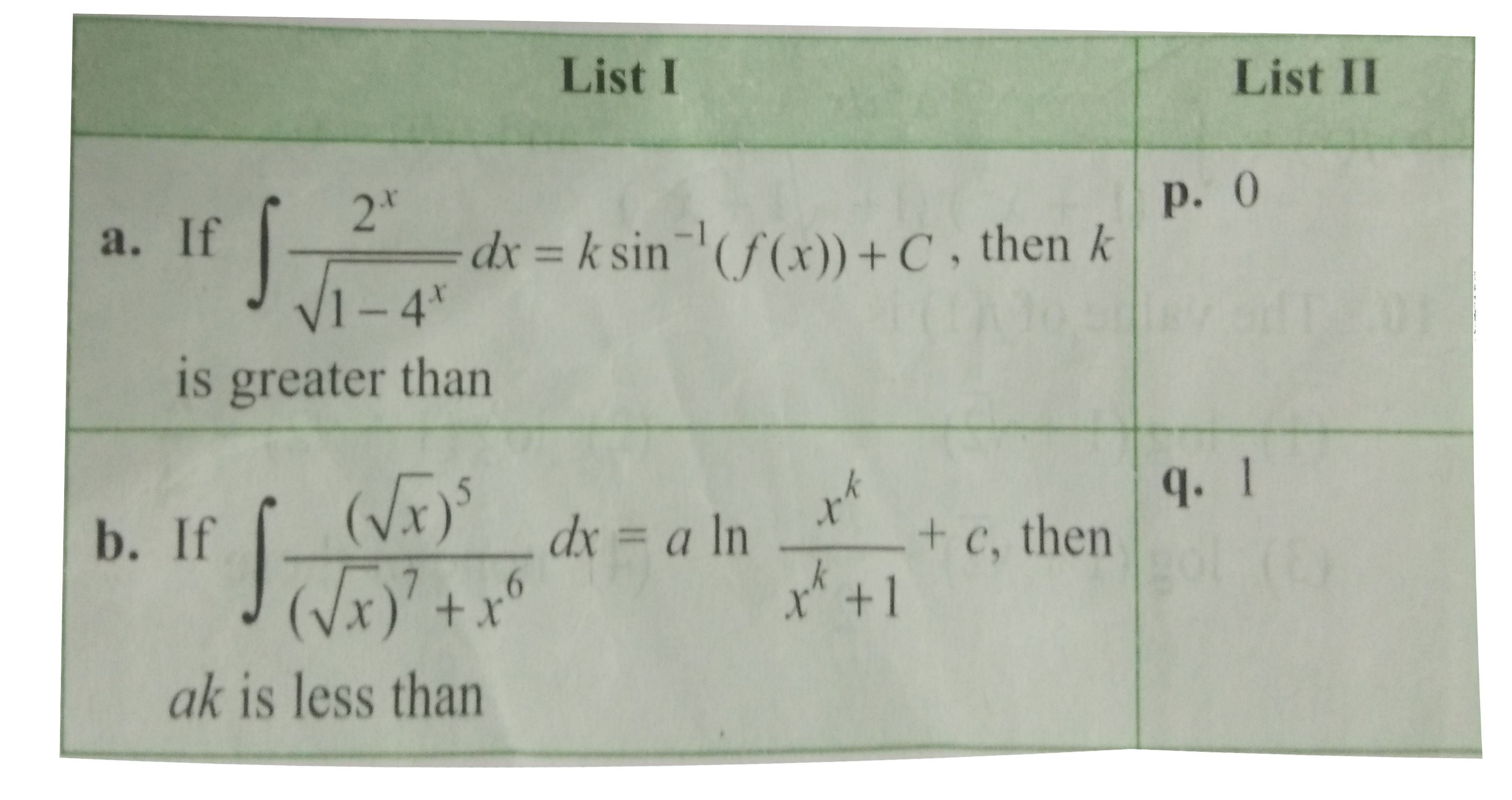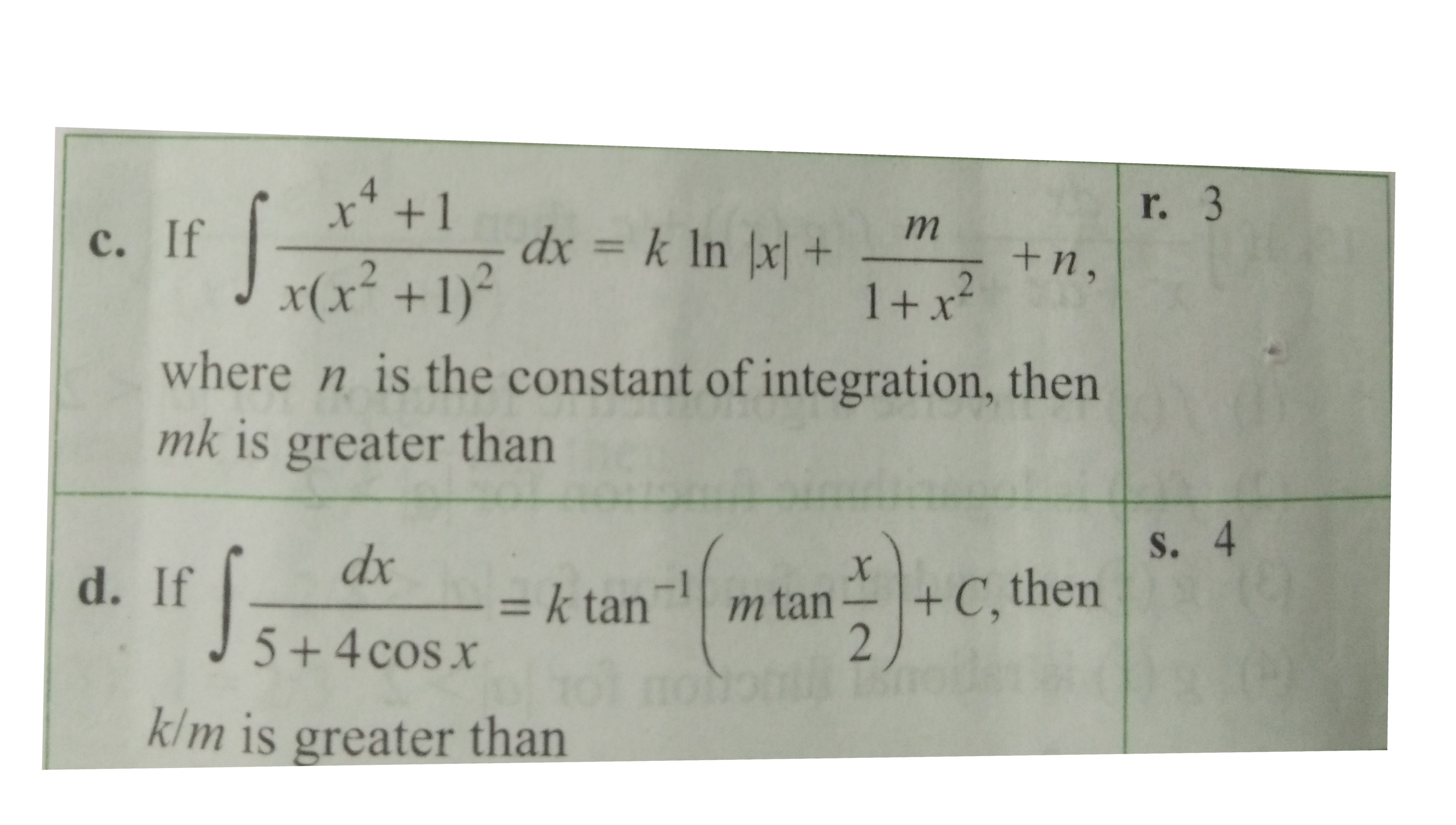If∫x4+1x6+1dx=tan−1f(x)−23tan−1g(x)+C,then
a) both f(x)andg(x)
are odd functions
b)f(x)
is monotonic function
c)f(x)=g(x)
has no real roots
d)∫f(x)g(x)dx=−1x+3x3+cSolution in Bengali
both f(x) and g(x) are odd functions
f(x) is one-one function
f(x)=g(x) has no real roots
∫f(x)g(x)dx=1x+3x3+c
The correct Answer is:A, C, D
Let I=∫(x4+1)(x6+1)dt=∫(x2+1)2−2x2(x2+1)(x4−x2+1)dx
=∫(x2+1)dx(x4−x2+1)−2∫x2dx(x6+1)
=∫(1+1x2)dx(x2−1+1x2)−2∫x2dx(x3)2+1
In the first integral, put x−1x=t, i.e., (1+1x2)dx=dt
and in the second integral put x3=u, i.e., x2dx=du3
Then I=∫dt1+t2−23∫du1+u2=tan−1t−23tan−1u+C
=tan−1(x−1x)−23tan−1(x3)+C
Here, f(x)=x−1xandg(x)=x3
Draw the graphs of f(x)andg(x) .
We find that f(x) is many-one and f(x)=g(x) has no real roots.
∫f(x)g(x)dx=∫x−1xx3dx=∫(1x2−1x4)dx=−1x+3x3+C
Topper's Solved these Questions
- BOOK - CENGAGE PUBLICATIONCHAPTER - INDEFINITE INTEGRATIONEXERCISE - Exercises (Linked Comprehension Type)17videos
INDEFINITE INTEGRATION
- BOOK - CENGAGE PUBLICATIONCHAPTER - INDEFINITE INTEGRATIONEXERCISE - EXERCISES (Matrix Match Type)4videos
INDEFINITE INTEGRATION
- BOOK - CENGAGE PUBLICATIONCHAPTER - INDEFINITE INTEGRATIONEXERCISE - EXERCISES (Single Correct Answer Type)77videos
INDEFINITE INTEGRATION
- BOOK - CENGAGE PUBLICATIONCHAPTER - HYPERBOLAEXERCISE - COMPREHENSION TYPE2videos
HYPERBOLA
- BOOK - CENGAGE PUBLICATIONCHAPTER - INEQUALITIES AND MODULUSEXERCISE - Single correct Answer21videos
INEQUALITIES AND MODULUS
Similar Questions
y=f(x) is a polynomial function passing through point (0, 1) and which increases in the intervals (1,2)and(3,∞) and decreases in the intervals (∞,1)and(2,3).
If f(1)=−8, then the value of f(2) is07:43View SolutionMatch the following lists:

 04:56View Solution
04:56View SolutionI=∫sin8x−cos8x1−2sin2xcos2xdx is equal to:
02:15View SolutionThe circle x2+y2−8x=0 and hyperbola x29−y24=1 I intersect at the points A and B. Equation of a common tangent with positive slope to the circle as well as to the hyperbola is (A) 2x−√5y−20=0 (B) 2x−√5y+4=0 (C) 3x−4y+8=0 (D) 4x−3y+4=0
04:05View SolutionIf f(x)=ax2+bx+c and f(−1)≥−4, f(1)≤0 and f(3)≥5, then the least value of a is
View SolutionIf∫x4+1x6+1dx=tan−1f(x)−23tan−1g(x)+C,then both f(x)andg(x) are odd functions f(x) is monotonic function f(x)=g(x) has no real roots ∫f(x)g(x)dx=−1x+3x3+c
06:40View SolutionIf f(x) is polynomial function such that f(x)+f'(x)+f(x)+f'(x)=x^(3) and g(x)=int(f(x))/(x^(3)) and g(1)=1 then g( e ) is
15:44View SolutionIf the function f(x)=x3+ex2andg(x)=f−1(x), then the value of g'(1) is
09:37View Solution∫(f'(x)g(x)+f(x)g'(x))(1+(f(x)g(x))2)dx is where C is constant of integration
03:41View SolutionLet f(x)=(a−x)1/nandg(x)=f,f,f,......,f(x)2m times. Then ∫dx(g(x))n(1+(g(x))n)1/n equals
01:48View Solution(A) For each of the following function f(x), verify that: ∫20f(x)dx=∫10f(x)dx+∫21f(x)dx: (i) f(x)=x+2 (ii) f(x)=x2+2 (iii) f(x)=ex (B) For each of the following pairs of function f(x) and g(x), verify that: ∫10[f(x)+g(x)]dx=∫10f(x)dx+∫10g(x)dx: (i) f(x)=1,g(x) =x2 (ii) f(x)=ex,g(x)=1
03:01View SolutionIf∫x4+1x6+1dx=tan−1f(x)−23tan−1g(x)+C,then both f(x)andg(x) are odd functions f(x) is monotonic function f(x)=g(x) has no real roots ∫f(x)g(x)dx=−1x+3x3+c
05:49View SolutionSuppose that f(x) is differentiable invertible function f′(x)≠0andh′(x)=f(x). Given that f(1)=f′(1)=1,h(1)=0 and g(x) is inverse of f(x) . Let G(x)=x2g(x)−xh(g(x))∀x∈R. Which of the following is/are correct? G′(1)=2 b. G′(1)=3 c.G1=2 d. G1=3
03:37View SolutionIf the function f(x)=x3+ex2andg(x)=f−1(x) , then the value of g'(1) is
04:24View SolutionIf the functions f(x)=x3+ex/2 and g(x)=f−1(x), the value of g'(1) is ………… .
05:28View SolutionIf the function f(x)=x3+ex2 and g(x)=f−1(x) then the value of g′(1) is
06:22View Solution

